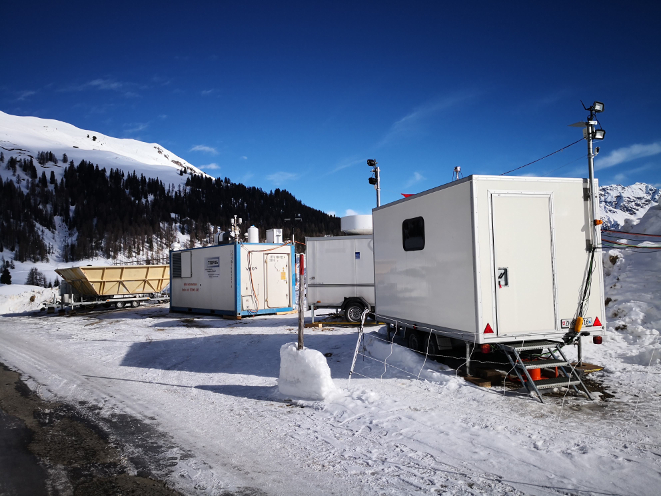Aerosols
During the RACLETS campaign aerosol properties were measured in Davos Wolfang (LON: 9.853594, LAT: 46.835577), at an elevation of 1630 m above sea level (a.s.l.), which is in a valley between lake Davos in the South and Laret in the North. The second measurement site for aerosol particles was on a mountain site, called Weissfluhjoch (LON: 9.806475, LAT: 46.832964), at an elevation of 2700 m a.s.l. The instruments were owned and operated by ETH Zurich and University of Basel.
The aerosol size spectra from 15 nm to 40 μ m were recorded with a combination of SMPS (model 3938, TSI Inc.), APS (model 3321, TSI Inc.), and OPCs (OPC-N3, Alphasense ; GT-526S Met One Instruments, Inc.). In-situ measurements of Cloud Condensation Nuclei (CCN) were carried out with a CCN chamber (CCNC, Droplet Measurement Technologies). LINDA (LED based Ice Nucleation Detection Aparatus, University of Basel), DRINCZ (Droplet Ice Nuclei Counter Zurich, ETH Zurich), and a cold stage were used to investigate ice nucleating particle (INP) concentrations by drop freezing experiments. Information about the secondary ice fraction was gained by melting and re-freezing single dendrites. For further chemical analysis, particles larger than 0.5 μm were collected with an air sampler (Coriolis μ, bertin Instruments) using a cyclone technology to separate particles from the air into the sample liquid.
Information on precipitation, wind, meteorological parameters, cloud properties and cloud composition were gained at the valley station. Snowflake properties were investigated at the mountaintop station.
HoloBalloon and radiosondes were launched close to the aerosol measurement station in Davos Wolfgang. The OceaNet container hosting remote sensing instruments and a disdrometer to measure precipitation were placed in the same area.

Image 1: Measurement site Davos Wolfgang. © Jan Henneberger.
Image 2: Measurement site Weissfluhjoch. © Claudia Mignani.
Additional Info
| Field | Value |
|---|---|
| parent | RACLETS Field Campaign |

